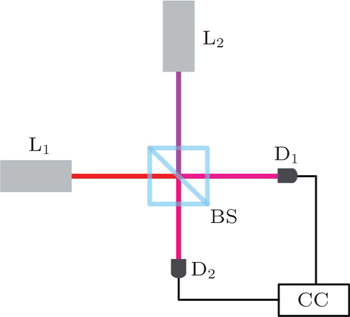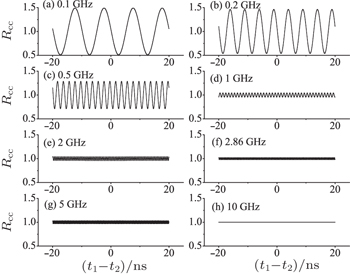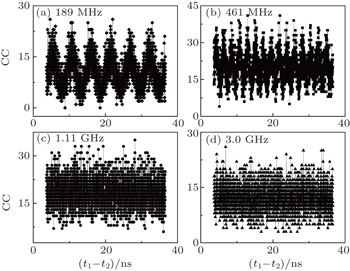† Corresponding author. E-mail:
Project supported by the National Natural Science Foundation of China (Grant No. 11404255) and the Doctor Foundation of Education Ministry of China (Grant No. 20130201120013).
The second-order temporal interference of two independent single-mode continuous-wave lasers is discussed by employing two-photon interference in Feynman’s path integral theory. It is concluded that whether the second-order temporal interference pattern can or cannot be retrieved via two-photon coincidence counting rate is dependent on the resolution time of the detection system and the frequency difference between these two lasers. Two identical and tunable single-mode continuous-wave diode lasers are employed to verify the predictions. These studies are helpful to understand the physics of two-photon interference with photons of different spectra.
In Feynman’s point of view, interference is at the heart of quantum physics and it contains the only mystery of quantum physics.[1] It should be helpful to understand quantum physics if interference is understood better. Interference can be divided into different categories based on different criteria. For instance, based on the source employed, interference can be categorized into interference with sound waves, photons, massive particles, etc. Based on the order, interference can be categorized into the first-, second-, third-, and high-order interference. Based on the valid superposition principle, interference can be categorized into quantum interference and classical interference.[2] Among all kinds of interference mentioned above, two-photon interference is an ideal tool to study the properties of interference in quantum physics besides single-photon interference. The reasons are as follows. Two-photon interference is a second-order interference phenomenon, which is the simplest higher-order interference of light. Photon is a quantum concept and two-photon interference belongs to quantum interference.[2,3] The interference experiments with photons are much easier than the ones with massive particles, so that the theoretical predictions can be verified conveniently.
Two-photon interference, which is also known as the second-order interference of light, was first observed by Hanbury and Twiss in 1956, in which they found that randomly emitted photons by thermal light source arrive at two detectors in bunches rather than randomly.[4] Theoretical explanations for this strange phenomenon advance the development of optical coherence theory. Among all the interpretations, Glauber’s quantum optical coherence theory may be the most successful one, which is usually thought as the foundation of modern quantum optics.[5,6] In Glauber’s quantum optical theory, two-photon bunching of thermal light can be understood by two-photon interference.[7] Two-photon interference has been studied extensively with photons in both classical and nonclassical states[8–10] since the observation of two-photon bunching of thermal light.[4] Recently, two-photon interference with photons of different spectra has drown lots of attention due to its possible applications in quantum information processing.[11–22] All the experiments did not take the resolution time of the detection system into account except Ref. [17], in which Flagg et al. pointed out that the observed dip is affected by the response time of the detector. In the recent experiments about the second-order interference of two independent lasers,[21,22] the influence of the resolution time on the observed interference pattern is not considered, either. In this paper, we will study in detail how the resolution time of the detection system affects the observed second-order interference pattern when the frequency difference between these two lasers varies. Two independent and tunable single-mode continuous-wave lasers are employed to verify theoretical predictions. We will also discuss the physics of two-photon interference with photons of different spectra, which is helpful to understand the physics of interference.
The organization of the following parts is as follows. In Section 2, we will theoretically study the second-order temporal interference of lasers with different spectra based on the superposition principle in Feynman’s path integral theory. The second-order interference experiments with two independent and tunable single-mode continuous-wave diode lasers are described in Section 3. The discussion and conclusions are given in Sections 4 and 5, respectively.
Although the second-order interference of classical light can be interpreted by both quantum and classical theories,[5,6,23] we will employ two-photon interference based on the superposition principle in Feynman’s path integral theory to interpret the second-order interference of two independent lasers with different spectra. Recently, we have employed this method to discuss the second-order subwavelength interference of light,[24] the spatial second-order interference of two independent thermal light beams,[25] the second-order interference between thermal and laser light,[26] etc. These studies indicate that the advantages of this method are not only simple, but also offer a unified interpretation for all orders of interference with photons in both classical and nonclassical states. The scheme in Fig.
There are three different cases to trigger a two-photon coincidence count in Fig.
When photons emitted by these two lasers are indistinguishable, the two-photon probability distribution for the j-th detected photon pair is[24,29]




Substituting Eq. (



In this regime, the observed two-photon coincidence counting rate is proportional to the two-photon probability distribution function modulated by a sinc function. In order to get an intuitive understanding about the relationship between two-photon coincidence counting rate and two-photon probability distribution function, figure
However, it should be noted that the simulations in Fig.

When a fiber beam splitter is put at one output of BS to measure the second-order temporal interference pattern as the one in Fig.

In Section 2, we have calculated two-photon probability distribution and coincidence counting rate in the second-order interference of two independent single-mode continuous-wave lasers with different spectra. In this section, we will employ the experimental setup in Fig.
The measured two-photon coincidence counts are shown in Fig.
In the last two sections, we have calculated the second-order temporal interference pattern of two independent single-mode continuous-wave lasers when the frequency difference varies and employed two tunable lasers to verify the theoretical predictions. The reason why the observed interference patterns are different when the frequency difference varies is dependent on the resolution time of the detection system and the frequency difference. When the resolution time is much less than the beating period, the observed two-photon coincidence counting rate is identical to the two-photon probability distribution function. The visibility of the observed interference pattern decreases as the frequency difference increases, which has been confirmed both theoretically and experimentally in Figs.
It is worth noting that although the second-order interference pattern cannot be observed when the frequency difference exceeds a certain value in our experiments, the second-order interference pattern still exists when the frequency difference is less than 1/Δtu. There is interference pattern in the simulation when the frequency difference is 2 GHz in Fig.
It is well-known that the observed result is dependent on the measuring apparatus in quantum physics. For instance, there is no two-photon interference for photons with frequency difference larger than 10 GHz if the detection system based on photoelectric effect is employed. It does not mean there is no two-photon interference for other detection systems. For instance, the time measurement uncertainty of two-photon absorption is at 10−15 s range.[36] Photons with frequency difference less than 106 GHz are indistinguishable. There is two-photon interference when the frequency difference is less than 106 GHz for detection system based on two-photon absorption. Photons with different spectra are distinguishable for some detection systems, while these photons can be indistinguishable for other detection systems. When talking about the measured results in quantum physics, one has to pay special attention to the employed measuring apparatus.[37]
Although our calculations and experiments are for the second-order interference of classical light. The discussion and conclusions above can be generalized to the second-order interference of nonclassical light.[11,12,14–17,20] For instance, when these two lasers are replaced by two single-photon sources in Fig.
In conclusion, we have theoretically and experimentally studied the second-order temporal interference of two independent single-mode continuous-wave lasers when the frequency difference varies. Whether the second-order interference pattern can be retrieved via two-photon coincidence counting measurements is dependent on the resolution time of the detection system and the frequency difference of these two superposed lasers. When the resolution time is much less than the beating period, the observed two-photon coincidence counting rate is the same as two-photon probability distribution function. When the resolution time of the detection system is fixed, the visibility of the observed second-order interference pattern decreases from 50% to nearly zero as the frequency difference increases. When the frequency difference is larger than the inverse of time measurement uncertainty of the detection system, there is no two-photon interference for the different alternatives to trigger a two-photon coincidence count are distinguishable. The results are helpful to understand the second-order interference of light in the languages of photons.
| 1 | |
| 2 | |
| 3 | |
| 4 | |
| 5 | |
| 6 | |
| 7 | |
| 8 | |
| 9 | |
| 10 | |
| 11 | |
| 12 | |
| 13 | |
| 14 | |
| 15 | |
| 16 | |
| 17 | |
| 18 | |
| 19 | |
| 20 | |
| 21 | |
| 22 | |
| 23 | |
| 24 | |
| 25 | |
| 26 | |
| 27 | |
| 28 | |
| 29 | |
| 30 | |
| 31 | |
| 32 | |
| 33 | |
| 34 | |
| 35 | |
| 36 | |
| 37 | |
| 38 |







